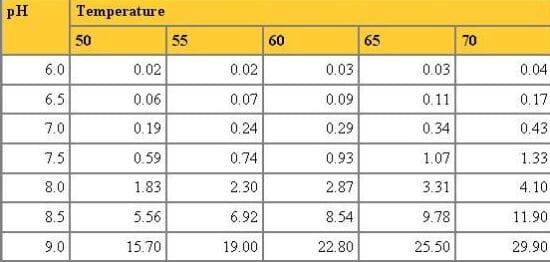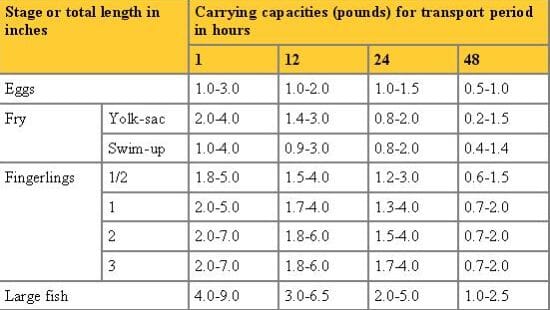Introduction
Bag shipment requires placing a prescribed weight of fish in 1.5 to 2 gallons of water in 3 ml polyethylene bags, 18 by 32 inches. Excess air is removed from the bag and replaced with pure oxygen. The bag is sealed, placed in an insulated container and finally into a cardboard shipping box and shipped.
Bag shipment may be the best choice for the shipper for several reasons. First, very small fish and fry could be damaged by being shipped in large tanks. Second, due to the extreme distances involved, bag shipment may offer economic advantages over standard tank transportation. This fact sheet will focus on transport of fish. With minor modifications the techniques and principals discussed also apply to shellfish.
Water quality during shipping
Fish health is affected by changes in water quality parameters while in the plastic bags during the transportation process. The parameters to be considered are temperature, dissolved oxygen, pH, carbon dioxide, ammonia and the salt balance of the fish's blood. The rate of change of each parameter is affected by the weight and size of fish to be transported and the duration of transport.
Temperature
Fish are cold-blooded, so the metabolic rate of fish is affected by the temperature of the environment. The metabolic rate of fish will double for each 18 degree F increase in temperatures and be reduced by half for each 18 degree F decrease in temperature. A reduced metabolic rate will decrease the oxygen consumption, ammonia production and carbon dioxide production. Therefore, it is essential to transport fish as low temperatures. For cool and warm water species a temperature of 55 degrees to 60 degrees F is recommended. For species such as tilapia and red drum temperatures should be nearer to 60 degrees F. Cold water fish, such as trout, inhabit colder water and should be transported at even colder temperatures, such as 45 to 50 degrees F.
To achieve the desired transport temperature, fish should be held in tanks of cool water. By holding the fish in tanks for two days, the water temperature can be gradually reduced by adding cool water. After loading the fish into bags, final decreases and maintenance of temperatures during transport can be accomplished by adding ice or (more commonly) gel packs.
Ice or gel packs often are used during transport, especially over longer transport periods that might allow increases in temperature. One-half pound of ice will reduce the temperature of one gallon of water by about 10 degrees F. Insulated Styrofoam shipping boxes also are used to prevent outside temperatures from affecting the temperature of transport water. In some instances, 20 to 40 quart coolers are used for transport.
Dissolved oxygen
The most important single factor in transporting fish is the provision of adequate concentrations of dissolved oxygen (DO). The importance of supplying adequate levels of DO cannot be overemphasized. Failure to do so results in severe stress which may contribute to fish kills two to three days after transport.
The amount of oxygen that can be dissolved in fresh water is based primarily on water temperature. The water is referred to as 100 percent saturated when the upper saturation level is reached. DO saturation is higher for cool water than for warm water. For example, at sea level DO saturation of 45 degrees F water is 12.1 parts per million (ppm) but at 60 degrees F, saturation is 10.0 ppm. Because pure oxygen is used during bag transport, DO levels in the water will be saturated and the low oxygen levels usually will not be a problem unless the bag is improperly sealed or develops holes caused by the spines of large fish. It is important to have a 75 percent volume of oxygen in the bag to ensure adequate diffusion of oxygen at the surface of the water.
The quantity of hydrogen ions (H+) in the water will determine if it is acidic or basic. The scale for measuring the degree of acidity is called the pH scale, which ranges from 1 to 14. A value of 7 is considered neutral, neither acidic nor basic; values below 7 are considered acidic; above 7 basic. The acceptable range for fish growth is between pH 6.5 and 9.0. The pH of water will be influenced by the alkalinity (buffering capacity) and the amount of free carbon dioxide. The pH of the transport water will also affect the toxicity of ammonia. Even in well-buffered transport water the pH will sometimes decrease by one pH unit.
Carbon dioxide
As fish respire they produce carbon dioxide as a byproduct. Carbon dioxide reacts with water to form a weak acid. This weak acid will in turn decrease the pH of the water. High levels of carbon dioxide (greater than 20 ppm) will interfere with the oxygen uptake in the fish's blood. High levels of carbon dioxide sometimes are found in well water. Excess carbon dioxide in well water can be reduced by mechanical aeration or by passing the water through a degassing column.
Ammonia
Ammonia build up occurs in transport water as a result of fish metabolism and, to a lesser extent, bacterial action on fish waste excreted into the water. Two forms of ammonia occur in transport water: ionized (NH4+), and un-ionized (NH3). Unlike the ionized form, the un-ionized form of ammonia is extremely toxic at concentrations as low as 0.2 ppm. In tests for ammonia, both forms are grouped together as "total ammonia nitrogen" (TAN). The percent of ammonia that is un-ionized will depend on both temperature and pH (Table 1).
Total ammonia concentrations may reach more than 14 ppm during transport. However, using Table 1, the percent of the total ammonia which is un-ionized at pH 6.5 and 55 degrees F is only 0.07 percent. Therefore, the un-ionized ammonia concentration at 14 ppm is 14 x 0.0007 = 0.0098 ppm. Un-ionized concentrations greater than 0.05 ppm should be handled with caution.
The easiest way to reduce toxic ammonia buildup in transport water is to lower the temperature of the transport water and to stop feeding several days before transporting. Fish up to eight inches long should not be fed for 48 hours before loading and transporting and those larger than eight inches should not be fed 72 hours before transporting.
Table 1.
Percent of ammonia in the un-ionized form of different temperatures (degrees F) and pH values
 |
Chemical additives
Numerous chemical additives can be added to the transport water to alleviate several problems associated with transporting fish in bags. Since overdoses of chemical can cause death, care must be taken when measuring the dosage of each chemical. It is essential to double check every calculation and to use an accurate balance when weighing chemicals.
The most common chemical added to transport water is salt (NaCl). Salt is used to relieve stress associated with maintaining a water balance in the fish. Freshwater fish have a blood salt concentration higher than the salts of the transport water. As a result, the fish are continually losing salts to the surrounding water. Concentrations of 5,000 ppm (0.5 percent) are commonly used. A 5,000 ppm concentration can be made by adding 19 grams (one tablespoon) of salt per gallon to water used during transport. Use non-iodized salt that contain no anti-caking compounds. Canning salt is a good example.
If the alkalinity of the transport water is less than 100 ppm, some type of buffering compound should be added to the water. Properly buffered water will help remove freed carbon dioxide which causes drops in pH. Sodium bicarbonate (Na2CO3) is one of the fastest reacting buffers and should be added at a rate of 1 g per gallon. of water. Finally, the fish will suffer some stress because they are transported in crowded conditions. Sometimes a chemical anesthetic may be beneficial by producing a light sedation. The only anesthetic approved by Food and Drug Administration (FDA) for food fish is Finquel (tricaine methanesulfonate). Finquel may be used at a rate of 0.06 to 0.25 g per gallon. of water.
Carrying capacity
The maximum weight of fish that can be safely transported within a given period of time is the carrying capacity. The carrying capacity depends on the duration of haul, water temperature, fish size and fish species. If water quality conditions such as temperature, oxygen, carbon dioxide, alkalinity and ammonia are constant, then carrying capacity will depend on the fish species. In general, fewer pounds of smaller fish can be transported per gallon of water than larger fish. General carrying capacity guidelines are given in Table 2. It is important that first-time or experienced shippers handling a new species test-run a batch before undertaking a large shipment.
Table 2.
Carrying capacity in pounds of warm water fish transported in 18- x 32- inch polyethylene bags containing 2 gallons of water (about 15 pounds). Water should be moderately hard (80 to 100 ppm total hardness) and have a temperature range of 55-60 degrees F (Dupree and Hunter, 1984)
 |
Transport procedure
Days before the fish are loaded and transported, the shipper should determine the carrier to be used, time of departure, time of arrival and shipping costs. This information needs to be communicated to the receiver well before the shipping date. All loading should be planned to allow boxes to be shipped as soon after loading as possible. With proper planning, unnecessary delays in delivery and pickup can be avoided. The receiver is responsible for contacting the shipper if any deaths occur.
Procedure for shipping fish:
- Carefully add the proper weight of fish to 1.5 to 2 gallons of clean high quality water. Water contained in the bag needs to be within two degrees of the holding water. Chemicals, if any, need to be added at this time.
- Deflate to remove air and then fill with pure oxygen. Approximately 75 percent of the volume in the bag should be oxygen.
- Twist mouth of bag tightly and secure with heavy-duty rubber bands. Castration rings or heat sealing may also be used. Place bag inside a second bag, which has a frozen gel pack, and seal the bag.
- Place the sealed bag inside a cardboard shipping box and seal the box. The shipping box must be clearly labeled "Live Fish," with the name and address of the shipper and receiver displayed prominently. In the case of trips which may expose the bags to extremes of heat or cold, the bags may need to be placed inside a Styrofoam cooler before being packed into the shipping box.
Unpacking is as important as packing fish in bags. Guidelines for proper unpacking are as follows.
- Float unopened bags in a shaded area of the receiving water for at least 30 minutes to allow temperature to equalize. Check water temperatures and watch for mortalities.
- Open bags and add 2 to 3 gallons of receiving water to the bag.
- Gently and slowly pour fish into the receiving water.
Dupree, H.K. and J.V. Huner, 1984. Third Report to Fish Farmers. U.S. Fish and Wildlife Service, Washington, D.C.
Piper, R. G., I.B. McElwain, L.E. Orme, J.P. McCraren, L.G. Fowler, and J.R. Leonard, 1982. Fish Hatchery Management. U.S. Fish and Wildlife Service, Washington, D.C. 517 pp.
S.K. Johnson, 1988. Transport of Fish and Crustaceans in Sealed Containers. Inland Aquaculture Handbook. Texas Aquaculture Association, College Station, TX. A1504-A1509.
January 2007


